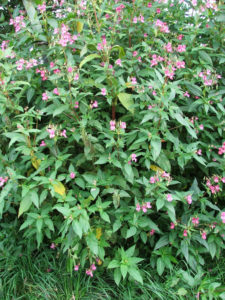In partnership with Necanicum Watershed Council, North Coast Land Conservancy has begun a three-year project to aggressively seek out and destroy policeman’s helmet (Impatiens glandulifera), an invasive plant that, in just four years, has spread widely throughout the Necanicum watershed.
 A stand of policeman’s helmet. Credit Simplicius
A stand of policeman’s helmet. Credit Simplicius
The two organizations are looking for experienced kayakers to adopt stretches of the Necanicum River and survey it this spring for patches of the plant, which tends to grow in clusters on or near riverbanks.
A training session will be held Saturday, May 20, from 1 to 5 p.m. in Seaside. At the training, participants will learn how to identify policeman’s helmet, what impact the weed is having on the Necanicum watershed, and how to use free weed-mapping apps to record occurrence of policeman’s helmet along the river using a smartphone. At the training, participants will choose a stretch of the Necanicum to survey.
Kayakers must be available to survey the river by June 15, or before river levels drop too low to paddle. Participants must have their own boat and other necessary paddling gear as well as a smartphone. All participants will receive a waterproof mobile phone case to thank them (and to keep their phone dry during the survey).
Policeman’s helmet is a weed that grows in moist soil along riverbanks. It is native to the Himalayas and was introduced in North America as an ornamental garden plant but has since spread widely. Dense patches of policeman’s helmet choke out other plant species and reduce native plant and animal diversity while increasing the risk of stream bank erosion.
For more information about the kayak survey project, visit NCLCtrust.org/citizen-science-kayakers.

